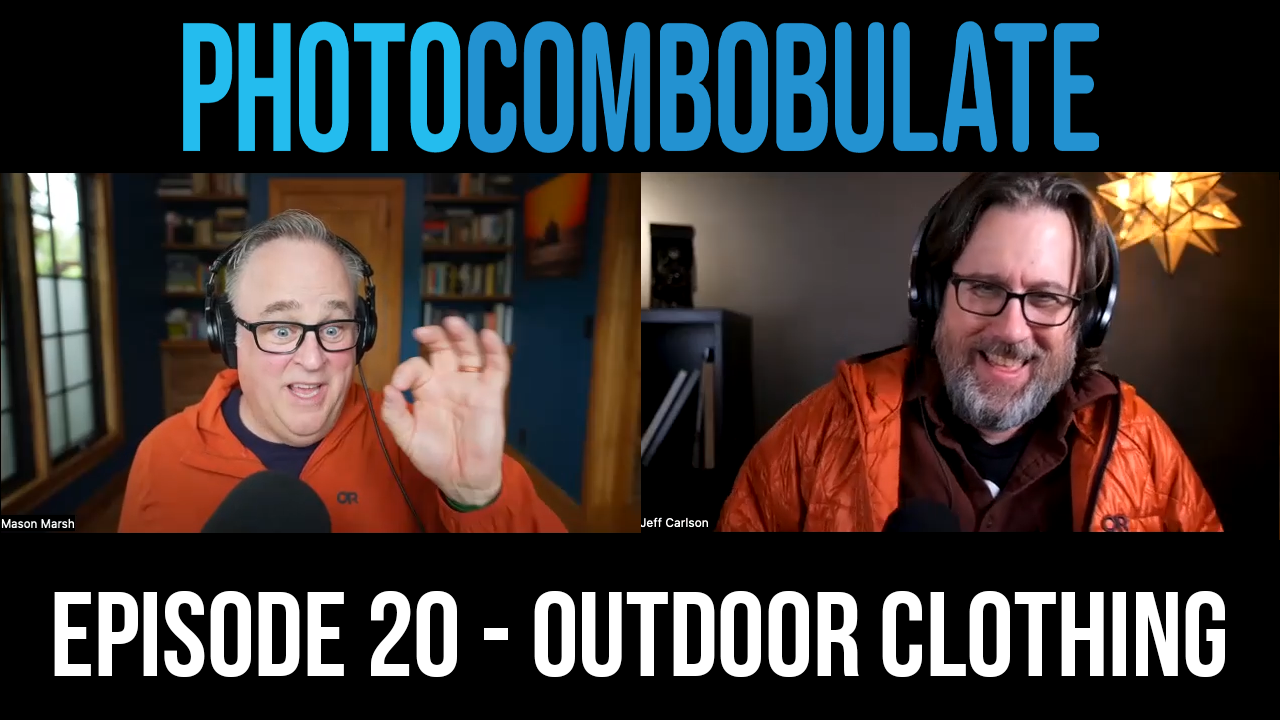Episode 20: Outdoor Clothing
Maybe you’ve been there. The light on the landscape is eye-popping as storm clouds streak across the sky sending the awesomeness factor soaring. You’re there with your camera ready to make some of the best images of your life and you could not care less because your feet have gone numb, your knees are knocking from the cold and the damp shirt that was mildly annoying an hour ago has become an bone-chilling cloak of suffering. Your hands have become useless claws and you’re dreaming about hot showers and fluffy dry socks, not snapping photos. It’s these moments that illuminate the brutal truth that your outdoor clothing may be the most important camera gear you own.
In this episode we’re talking about the latest technology in outdoor clothing, with an emphasis on what works best for outdoor photographers, because we have unique needs. From the bottoms of your feet to the top of your head, we detail the best gear to keep you comfortable and undistracted from your creative process.
When in Iceland, glacial futons are all the rage. Here is Mason decked out in his finest cold-weather finery. Up top he has three layers: a lightweight T-shirt, a breathable fleece cardigan, and a synthetic-fill waterproof shell - all by Patagonia. Below he’s wearing a wicking pair of boxer briefs by Outdoor Research under his favorite pants, the Keb Trousers by Fjallraven. On his feet are Smartwool merino wool socks and Gore-Tex light hiking boots by Adidas.
Layers, Layers, Layers!
If you’re outside, the environment may be busy at work trying to kill you. Be it from the sneaky surprise of hypothermia or the miserable sufferfest of Heat Stroke, anyone seeking life outside of the protective bubble of air-conditioned comfort must dress appropriately. Here’s our basic advice: layer up, Buttercup. Make those layers a system of materials that work together to maintain a cozy micro-climate next to your skin and you’ll be relatively blissful in pretty inhospitable conditions. Bring on the layers!
BASE
In hot climes, this may be all you need. In colder weather, this next-to-skin layer is meant to help your body regulate its temperature by transporting moisture from the skin to the open air where it can evaporate. In sunny hot weather this will keep you cooler, and the layer will provide sun protection. In cooler conditions staying dry means staying warm, so it’s the best place to start. Base layers should be highly-wickable fabric like natural wool (Merino is best) or synthetic materials. Cotton does not wick well, but can be fine in warm and dry conditions.
GOOD - REI Co-op Lightweight Base Layer Crew Top, Men’s Women’s
BETTER - Icebreaker Merino 175 Everyday Short Sleeve Crewe Top, Men’s Women’s
MID
Here is Jeff decked out in his incredibly-photogenic puffy coat. See that smile? It’s 21 degrees and windy, the man is wearing jeans and all the layers he could find, but that puffy… that puffy is keeping the wind out and his hard-fought warmth in. That is the Helium Insulated Hoodie by Outdoor Research.
Mid layers are where the insulation comes in. In milder conditions, this warm mid layer can also be the outer, protective layer if done right. As part of the system we are building to transport moisture from the skin to the open air, the mid layer needs to breathe while trapping warmth. Fleece and “puffy” midlayers are awesome, but each has drawbacks. Fleece is very breathable and wick-able, but it does not compress very well, so when it’s time to shed the layer it may be a hassle to find a place to stuff it. Fleece can also generate a static charge in very dry conditions. Puffy mid layers are very compressible, so they stuff into packs well, but they don’t breathe as well due to the shell fabrics involved, (you try to keep little feathers all in one place! It’s a challenge). Puffy coats can be filled with synthetic spun fibers of some sort of plastic or natural down from geese or some other poor birds. Down is lighter and warmer, but once wet is a big bummer, (plus it’s made from bird feathers, so those trying to avoid animal products should look elsewhere). Synthetic is great in wet conditions and works great to wick moisture away from your skin, but the fibers are made of materials derived from petroleum (usually), so it’s not something you want to buy every month. Invest in the fill you prefer and be sure the item is built to last. Fleece or puffy, these pieces of clothing are investments that do the majority of the work keeping you cozy in the cold, so “Buy once, cry once.” applies.
FLEECE
GOOD - Patagonia Micro D Snap-T Pullover, Men’s Women’s
BETTER - Outdoor Research Vigor Plus Jacket, Men’s Women’s
BEST - Mountain Hardware Polartech High-Loft Jacket, Men’s Women’s
DOWN PUFFY
GOOD - REI Co-op 650 Down Hoodie, Men’s Women’s
BETTER - Fjallraven Expedition Pack Down Hoodie, Men’s Women’s
BEST - Mountain Hardware Ghost Whisperer 2 Hoodie, Men’s Women’s
SYNTHETIC PUFFY
GOOD - REI Co-op Flash Insulated Jacket, Men’s Women’s
BETTER - Outdoor Research SuperStrand LT Hoodie, Men’s Women’s
PANTS
What you cover your butt and legs with is complicated. Your legs do much of the work of moving you about in the outdoors, and that effort produces a lot of heat down there. As we travel through the wilds, a lot of the natural world is there to rub up against, so covering those legs is often wise, so hot legs get wrapped in all kinds of thick protective fabric, much of it water proof to keep the wet stuff at bay. This makes for a challenge as you’ll want to regulate the temperature of your lower half to dump the heat and moisture produced by power-walking to your favorite viewpoint, while protecting those gams so you’re not a bloody mess when you arrive.
A great solution is a robust pair of field pants designed to stretch and move with you as you work, but still give good protection from brush and rocks. When you need to get low, coated knee and butt panels make ground contact less soggy too. A truly worth-while investment is a well-engineered set of trousers from Swedish company Fjallraven. The prices of their various trekking trousers are gasp-inducing but they can be found at a discount if you are willing to look. Mason swears by his Keb Trousers. They have waxed canvas panels where they are needed, and breathable 4-way stretch soft shell material everywhere else to vent moisture and keep things comfortable. Leg zippers work wonders when things get too warm, but shorts are still a bad idea.
When it pours, a hard shell is in order. Here Julie and Claire (Mason’s better half and daughter) make quick work of storm puddles in their waterproof-but-breathable shell jackets and pants. Julie’s sporting a REI Co-op Rainier Rain Jacket and Sierra Designs pants while Claire is decked out in a REI set of shells. Under that water both are wearing calf-high rain boots.
SHELLS
Veteran outdoor photographers will tell you- when it’s stormy, those are the days the epic shots are made. What they may not mention is the hours spent trudging through the pouring rain to get those shots can leave you steamed up and soggy. Real trouble can come when you build up a sweat walking to your location, then you stop and cool down. A well-considered system will move that moisture away into the atmosphere where it can mingle with the storm. The key is the temperature differential between your skin and the outside air. Here’s how it works:
The base layer you’ve chosen is against your skin and it loves to move sweat from you to the outer layers quickly. As that base layer wicks the sweat out, it’s transferred to the mid layer which absorbs it and the heat your skin is producing. The heat helps drive the water molecules through the layer where it can pass into the shell layer. If you’ve built a good system, it’ll be topped with a breathable hard shell (often branded as Gore-Tex). Within this shell there are three (maybe more) layers. The first stop is a wicking layer that gathers the moisture and gets it ready for passage through the microporous membrane. That’s right, there’s a thin layer of super science in there! This membrane is perforated with tiny, tiny little holes just a wee bit bigger than a water molecule. The heat you’ve pooled under the shell will force the water molecules through the membrane into the outer shell layer, which is usually a hydro-phobic nylon material coated with a chemical Durable Water Repellant that encourages water to bead up and roll off the fabric. So if it’s raining, your sweat will simply join the rain sliding off the shell. If it’s not raining, the sweat will quickly evaporate from the outside of the shell.
Pretty cool, as long as it works.
The system fails when the temperature differential isn’t large enough to drive the moisture you produce (sweat) through the base, mid and outer shell layers. In fact, if it’s warmer on the outside of your clothing moisture can work its way to your skin following the same path. So, if you’re not making a lot of heat by working your body, it might not work well.
Photographers are prone to this problem as we build up heat and sweat on our walk to location, then we loiter and cool down. If we don’t keep the furnace stoked, we’ll either get cold from the moisture we made on the way in, or we’ll get cold from the moisture that sneaks in through our shells. To mitigate this issue, be sure to take a moment to dry your base and mid layers by unzipping when you stop. Remember “pump and dump”. Open your shell and flap it around. If it’s not raining, take it off entirely and turn it inside out so it can dry while you air dry your mid and base layers in the breeze. In a few minutes, pop the shell back on and zip back up to trap heat and stay warm, without that pesky sweat.
Here are some shells that will be worthy of your investment:
BREATHABLE
GOOD - Patagonia Torrentshell 3L Jacket, Men’s Women’s
BETTER - Mountain Hardware Stretch Ozonic Jacket, Men’s Women’s
BEST - Arc’Teryx Beta Jacket, Men’s Women’s
NOT BREATHABLE (For Driving Rain and Low-Output Activity)
GOOD - Helly Hansen Moss Rain Jacket, Men’s Women’s
BETTER - Columbia Sportswear OutDry Ex Reign Jacket, Men’s Women’s
BEST - Fjallraven Anorak No. 8, Men’s Fjallraven Karla Lite Jacket, Women’s
Pump and Dump. Jeff started the morning in California’s Alabama Hills bundled against the mountain chill, but climbing big rocks jacked his temperature so he’s seen here pumping and dumping. See, it’s not what you thought.
Some things must be seen to be believed.
We produce minimally-edited video versions of our episodes on our YouTube channel. If you’d like to see us gesticulate like carnival barkers, here’s your chance.






